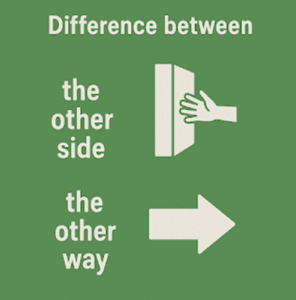Why We Say “The Other Side” but Not “The Other Way”-Grammar Puzzle Solved (3)
English learners often ask why we can say “the other side” when referring to the left or right, but not “the other way” in the same context. At first glance, both expressions seem reasonable. So, what makes one common and the other confusing? The answer lies in how we understand spatial language and abstract direction.
The Difference Between “Side” and “Way”
The term “side” usually describes a fixed position—such as the left or right portion of something. When someone says, “Go to the other side,” they are typically referring to a specific, opposite place relative to where the person currently stands.
For example:
-
He moved to the opposite part of the table.
-
She stood across from me on the far portion of the street.
In both cases, the phrase in bold can be replaced with “the other side.” That’s because side implies one of two spatial options—this one or that one—making it natural to say “the other” when choosing between them.
In contrast, the word “way” refers to direction, method, or manner. It is more abstract and less anchored in physical location. Therefore, using “the other way” to refer to a position (like standing left or right) doesn’t fit naturally.
When “The Other Way” Is Correct
Although awkward for spatial reference, “the other way” is perfectly valid when discussing directional movement or approach:
-
He turned and walked in the opposite direction.
-
You’re doing it wrong—try a different method.
In these examples, the phrase in bold shows correct contexts where “the other way” is acceptable. It describes how something is done or where someone is headed, not where someone or something is located.
Why the Confusion Happens
The confusion arises when English learners treat “way” as interchangeable with “side.” This often leads to incorrect constructions like:
-
❌ He stood on the other way of the road.
That sentence is incorrect because you can’t stand “on a way”—you stand on a side. A way is something you travel through or follow; a side is somewhere you can be positioned.
Final Thoughts
We say “the other side” when referring to fixed positions like left or right because the term logically fits into a two-part physical division. Meanwhile, “the other way” only makes sense when describing an alternative method or a different direction of movement. Knowing how each term works helps avoid these small but important grammar missteps.

Piers Plowman Poem Summary: https://englishlitnotes.com/2025/06/07/piers-plowman-poem-summary/
Jonathan as an American National Writer:
https://americanlit.englishlitnotes.com/jonathan-edwards-early-national-american-writer/
Louis Pasteur by Margaret Avery:
https://englishwithnaeemullahbutt.com/2025/06/02/louis-pasteur-margaret-avery/
Difference Between Little, A Little, and The Little: https://grammarpuzzlesolved.englishlitnotes.com/difference-between-little-a-little-the-little/
Visit ChatGPT to explore the platform and interact with the AI: https://chat.openai.com
Discover more from Grammar Puzzle Solved by Naeem Ullah Butt
Subscribe to get the latest posts sent to your email.